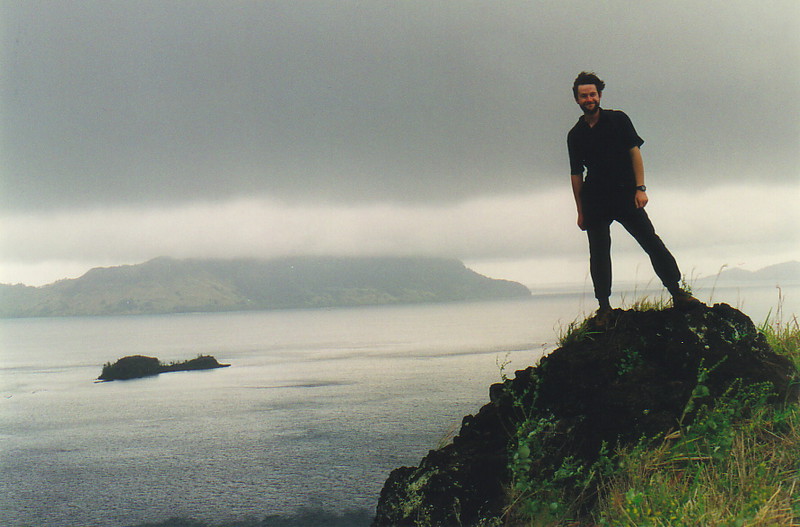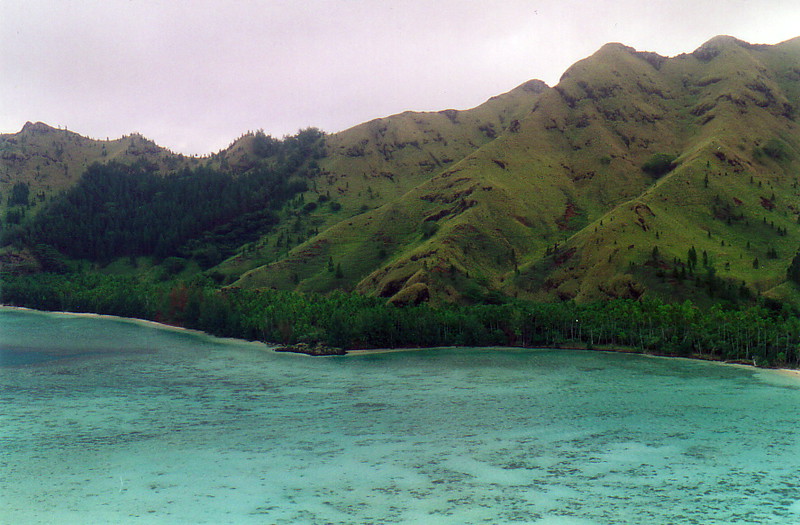
Given the way we were all getting on together it was logical that we should go off exploring the Gambiers together, so we teamed up with Joe and Janet on Tegan (unfortunately Peeyoo was about to leave for Tahiti on his yacht Rammen, so he was too busy to come with us). And so the four of us set off south towards a little sheltered spot off Île Akamaru, a reef-surrounded 246m-high peak just a short trip 7km southeast from Rikitea.
The Gambier lagoon is surrounded by a huge barrier reef (technically a large atoll) in the shape of a vertical diamond with points at north, south, east and west; this surrounds both the four main islands and the smaller islets dotted around. Île Mangareva, the northernmost island, is the largest and highest, and is home to almost all the people who live in the Gambiers (they mostly live in the village of Rikitea). The other islands are mostly uninhabited, and the only settlements you can see consist of one or two houses for workers on the pearl farms that form the basis for the islands' wealth. The anchorage we found near Île Akamaru proved to be pretty idyllic, with no houses in sight (except for a work hut on the beach that nobody lived in anyway) and coral reef everywhere. Akamaru is only inhabited occasionally, and is (in)famous for being the island where Laval and Caret celebrated their first mass in the Gambiers after they'd arrived in 1834.

Come to think of it, it's pretty damn hard for me to sit here on the deck of Zeke and describe how beautiful this paradise is, because however I rearrange phrases like 'stunning coral reef', 'striking volcanic peaks', 'palm-fringed beaches', 'deep turquoise water', 'sparkling sunshine', 'cloudless skies', 'gently lapping water', 'cool sea breezes', 'sweet and succulent fruit', 'hot white sand', 'unspoilt and uninhabited' and 'refreshing swimming', I still won't be able to describe just how amazing this paradise really is. The first step is to understand that paradise has nothing to do with what you see in the tourist brochures – cocktail bars, crowded beaches and only two weeks in which to cram a sun tan, three James Clavell novels and at least one cultural experience – so it's not all bumming around on the beach. This is the real thing, and we're not tourists, we're living here.
This became really apparent when we went for the beach barbecue experience, an off-the-cuff decision that simply isn't possible in places like Tahiti. In thanks for hosting the wonderful party the Saturday before, Rob and I invited Joe and Janet to join us for a genuine Aussie beach barbie, complete with real-fire barbecue and great food. It turned into another amazing night.
Barbecue in Paradise

I spent most of the morning slaving over a hot oven, creating some wonderful fresh bread, a great creamy banana pudding and some pasta salad with homemade pesto. I did, however, manage to grab the dinghy and go exploring on my own for a couple of hours, one of the true pleasures of having your own transport and life-support system in an island setting. I discovered a beautiful and tiny beach with a little reef just off it, and spent the afternoon snorkelling and reading a Graham Greene novel in the shade of a tropical tree. It set the scene perfectly for the barbecue itself.
For the barbie we had good old snags (sausages for those not used to Aussie English); sweet potatoes that we wrapped in foil, chucked in the fire and ate with butter (and which tasted great, despite the purple colour of the insides, a shock to those of us who weren't prepared for it); and possibly the strangest experiment of all, a breadfruit. This staple of the Pacific grows on trees all over the place, and is about the size of a football with a tough and knobbly green skin that looks totally unappetising. Shove a breadfruit in a roaring fire for a couple of hours, turning it regularly, and you end up with something about the size of a football with a tough and knobbly black skin that looks totally unappetising. However, smash it open when it's ready, and you end up with a strange white doughy substance that's vaguely bread-like and not at all bad with salt and butter. I prefer the other two ways to cook it – slice it up very thinly and fry it like potato chips, or chop it up into chunks and roast it – but there's something fun about the whole breadfruit-in-the-fire experience, as it's an essential part of Polynesian culture.
The cigars and rum made a welcome appearance too, with the rum adding a great kick to a milk and fruit juice concoction I'd whipped up, and as the almost full moon lit up the coral off the beach and the fire crackled away, casting shadows on the coconut palms above our heads and along the beautiful beach we'd decided to call home for the evening, I felt about as far away from the crazy world of commuting and stress as I'll ever be. I've gained another fantastic memory, and I'll gain a fair few more while cruising on Zeke; life can be very pleasant sometimes.
Under the Sea

We were enjoying ourselves so much that we decided to stay in the anchorage for the following day as well, and Joe made a fantastic Caesar salad for lunch, a thank-you for the night before. Real ground coffee made an appearance – wow, what a taste experience after all that instant coffee with powdered milk – and after relaxing for some hours, Joe and I took the dinghy over to the main reef and snorkelled for some time, exploring the reef and the local wildlife. As my first proper snorkelling session on coral it was quite an experience; the surreal shapes of the coral and the sheer intensity of the colours of fish you see are overwhelming.
The next day Rob and I decided to do some more serious diving, so we set off for the southernmost corner of the barrier reef, beyond all the islands. Here the coral looked promising for a Hookah dive, so we steamed out there and dropped anchor just before the seabed took a dive into the deep ol' Pacific.
A Hookah dive isn't scuba; with scuba you have everything in a self-contained unit, with an air tank strapped to your back and complete independence. A Hookah dive uses a compressor on the boat that feeds air down a long hose to a mouthpiece at the other end (hence the name, which comes from the tobacco pipes that people always claim they never use for marijuana, officer); the techniques for breathing are similar to scuba, but you don't have a buoyancy jacket and the air never runs out. The disadvantage, of course, is that you have to stay within 60m or so of the boat, but there is one big plus: there's nowhere in the Gambiers to refill scuba tanks, so once we'd emptied them, that would be the end of the diving until we found someone with a scuba compressor (unlikely until Tahiti). If your Hookah runs out of air, then it's a safe assumption that the rest of the planet has too.
The dive proved to be interesting, but probably not worth the few hours of travelling back into the wind we had to go through afterwards. If you add in the fact that I managed to get my hose in an almighty tangle, then it probably wasn't the best introduction to Hookah diving, but I can't complain; diving on coral is still a novelty for me, and even a mediocre reef is amazing at that stage in your diving career. The fish were pretty amazing, and the colours had to be seen to be believed; it truly is a different world on the bottom of the ocean.
Our return trip wasn't back to Île Akamaru, but to Île Agakauitai over on the western side of the group. The reason was that Rob had a mission: to find the caves of the cannibal kings. The story goes that before Laval came and screwed up all the fun, the locals buried their dead kings in caves on Agakauitai. We'd heard that the introduction of goats had rather screwed things up, seeing as the caves on the island are no more that indents in the mountains, and goats are no great respecters of the dead, tending to turf anything out of a cave they fancy for a home. However, Rob wanted to explore the island anyway, just in case anything was left, so we decided to spend the day climbing and exploring Île Agakauitai.
Predictably we didn't find any cannibal kings, but we did get some wonderful views, and there were some interesting bush-bashing opportunities. The weather wasn't that flash, and as we headed back to the boat the rain came in and made the rest of the night somewhat bumpy and blowy; returning to Rikitea the next morning was a welcome move, as Rikitea is about as sheltered as anchorages get.
Back in Rikitea we found Joe and Janet and settled back into the routine. Ah... harbour life. It's a home from home.